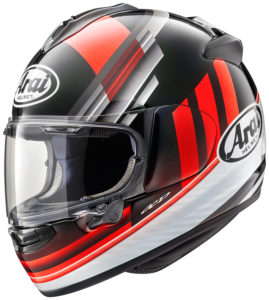“Handbuilt” is a popular buzzword right now, eschewing corporate anonymity and a throwaway culture in favor of personalization and a human touch—bonus points if the packaging uses an old-timey font. But seriously, in a world where looking the part has become more important than actually adhering to the handbuilt ideal, it’s easy to forget that there are some companies who have been doing just that since before you were a twinkle in your daddy’s eye.
Arai is one of those companies; this small, family-owned business has been making helmets in its Japanese factory for more than 60 years, and each and every one is made by hand. In fact, there are two—count them, two—people whose job it is to sign off on every shell that is produced. Graphics are hand-laid, holes are hand-drilled. Arai could be accused of being stuck in the past, but you have to give it credit for sticking to its mission: making the safest helmet possible—which isn’t necessarily what helmet the market wants. To the folks at Arai, if you want something they don’t make, go buy it somewhere else. They’ll keep making their helmets to their safety standards: a rounded, egg-inspired shape, minimal recessions in the shell, the strongest shell possible and as few cutouts in the EPS liner as possible.

Arai is also known for its distinctive shell shapes, Round Oval, Intermediate Oval and Long Oval, which allow the rider to choose the fit that’s right for them. I am an Intermediate Oval, which up until now has meant that my only two choices for an Arai street helmet were the “entry level” Vector 2 or the top-of-the-line, nearly $1,000 Corsair-X racing helmet. That has changed with the introduction of the newest helmet in the Arai street line, the DT-X.
Originally conceived as a replacement for the Vector 2, the DT-X (the DT stands for “DownTown”) evolved into a premium helmet that would fall into the general price category of the Signet-X (Long Oval) and Quantum-X (Round Oval), the bread and butter of Arai’s street line. Looking at the shell shape and vent positioning, the DT-X does bear a resemblance to the Vector 2. Compared to my size small Signet-X, the DT-X is smaller overall, more like my old Signet-Q. The fit, however, is sublime—better than the Signet-Q, and miles beyond my Signet-X and the overly round (for me) Quantum-X. I feel like Goldilocks: this one is juuuuuust right!

The DT-X gets the new PB-cLc (Peripheral Belt-complex Laminate construction) shell that the Signet-X and Quantum-X also use. Using Arai’s experience in Formula One racing, the PB-cLc shell has a reinforced upper eye port to protect this common impact area, and uses proprietary resins and Super Fibers to create a compact, lightweight shell. My size small DT-X weighs in at 3 pounds, 6.3 ounces, more than 2 ounces less than my small Signet-X.
The DT-X also gets the new VAS (Variable Axis Shield) system, which allows for a smoother shell at the temple area and a smaller pivot cover. It also fits Arai’s Pro Shade system, which is essentially an external drop-down sun shield. While still not exactly intuitive, changing shields is easier than on previous Arai helmets; you push on two black levers under each cover, popping them off, then rotate the shield up until it comes off. A bit of finagling gets the new one to slot in place, then more finagling to reattach the covers, and you’re done!

A new shield locking mechanism keeps it firmly closed, and like the shield change, mastering it requires a bit of a learning curve. First you push upwards on the lever with your thumb, which puts the shield in “de-mist” mode, allowing a tiny bit of airflow. Then hook your thumb under the shield edge and push out and up. With practice, it becomes one easy, fluid motion—although it was neither easy nor fluid when a wasp flew up into my helmet on our press ride. Fortunately, it was stunned by the impact and after a few terrifying seconds of panicked yanking at 60 mph, I was able to open the shield and free my little friend.
The DT-X has 10 vents, with a new “dual flow” design that pulls air through the vents, accelerating hot exhaust flow. While not quite as effective as the Corsair-X, I could still feel the air moving across my scalp, and it seemed to work regardless of my head position (tucked in or sitting upright). Despite the vents and the spoiler on the back, the DT-X was incredibly quiet and stable at speed; this would make a fine touring helmet.

The DT-X’s interior is soft and comfortable. The cheek pads have 5mm peel-away layers for custom fitting, and there are pockets cut out for speakers if you use a helmet comm system. A chin curtain is optional.
The takeaway is that Arai now offers helmets in its most popular “middle” category that fit all three head shapes—no more settling for what you don’t really want or need. The DT-X will be available in September in sizes XXS-XXL. Prices range from $589.95 for solids to $729.95 for graphics. For more information, see your dealer or visit araiamericas.com.













